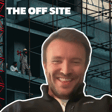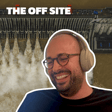Become a Creator today!Start creating today - Share your story with the world!
Start for free
00:00:00
00:00:01

E28: GIS, BIM or GEOBIM for Construction?
In this episode, Jason & Carlos are joined by Head of GIS at Skanska, George Floros.
The three delve into all things spatial data in construction, including the potential integration of GIS & BIM in the future (GeoBIM) to de-risk project delivery, accelerate business growth and improve productivity.
Transcript
Casual Conversations vs. Formal Meetings
00:00:00
Speaker
I've been listening to both of you guys and actually I've been enjoying it quite a lot. I was telling Carlos the other way, it's an interesting enjoyable conversation. It's not like you're jumping into another meeting and you have to be so formal and professional about anything. It's real. No one's going to accuse us of being formal and professional.
Carlos's Football Injury Story
00:00:36
Speaker
Hello and welcome to episode 28 of the Offsite podcast, where we chat all things construction and technology. My name's Carlos Caballo. And I'm Jason Lanzini. Carlos, how are you today? Not too bad, thanks. Pushing through the old pain of recovery.
00:00:52
Speaker
I see you're sporting a fashionable, you're sporting a fashionable new swing. Yeah, exactly. Yeah, if anyone for a bit of context, I managed to tear the socket off of my shoulder in a challenge of football. So they've drilled a bunch of holes into the bone and anchored the socket back in. So I'm a bit of a savage recovery, but I'll smile through it. That's for sure.
00:01:14
Speaker
Do you want to explain what you were doing? Were you going for, uh, best, uh, like bicycle kick or what was it? You like, is it something you shouldn't be doing at your advanced age? No, I, I wish it was a bicycle kick. Um, no, I went up for a simple header and as I jumped, someone else sort of aggressively jumped through the back of my arm, which popped it out forward. So, uh, I put on a brave face and walked off.
00:01:40
Speaker
Because most people think you're being dramatic in football if you roll around on the floor crying. So I just got on with that. And I got an MRI to tell me that actually wasn't okay. But that's all good. Well, being a QS, you know exactly who to sue for that. Yeah, exactly.
Meet George: GIS Expert at Skanska
00:01:58
Speaker
Right, today we've got a guest on the show. He is one of the most sort of prominent voices within the GIS space. He's also head of GIS at a contractor we know very well, which is Skanska. I'm surprised he's got enough time to join us considering how many panels he seems to be on at every event across the country each week.
00:02:19
Speaker
Welcome to the show, George. How are you? Good morning, everyone. Good morning, Jason and Carlos. Thank you. I'm great. What a nice introduction. Now I have to update my LinkedIn bio with this introduction, Carlos, and I will quote you underneath. It's a pleasure to be here. That's fine. You've got loads of followers. If you want a video of me as your LinkedIn bio, that's absolutely fine.
00:02:43
Speaker
I was doing with every guest that comes on the show, I always double check their LinkedIn page to have a bit of a stalk. Obviously we've met each other a little while, but I always have a check. I had no idea you're doing a PhD at the moment.
00:02:57
Speaker
Yeah, it's an amazing journey, Carlos. So I'm doing it part-time at University College, London. And I've always found research quite exciting. And I know this can be quite a boring conversational topic. But for me, research is about solving a puzzle or a problem that you don't know the answer to the first place, which is very much like construction, most of the times.
00:03:25
Speaker
So if you start exercising skills about problem solving and hopefully have some fun while you're doing it, I think it's an amazing and valuable skill set to have throughout your entire life. So that's one of my motivations behind my PhD and of course it's very closely linked to what I do on a day-to-day basis around GIS and building information modeling and asset management.
00:03:51
Speaker
So, you know, it's a topic that is really interesting to me. And my only suggestion is if someone would like to do it, by all means, it's very rewarding. It can be challenging. Just make sure you do it because you're really passionate about the topic. Otherwise, it becomes really, really challenging. Nice. Yeah, it's really impressive. And best of luck with it. Keen to see how that gets on.
The Importance of GIS in Construction
00:04:12
Speaker
No, thank you so much.
00:04:14
Speaker
To kick off, keen to get I guess your sort of, it's quite a broad question, but what are GIS systems and why do contractors use them? I really like this question Carlos and I'll start with
00:04:32
Speaker
my own view, which is very much around the need of separating data from technology. And we see this becoming harder and harder nowadays. So GIS definitely is interpreted as a GIS system, which can be a proprietary software or an open source software, but it's also founded on the management of geospatial or location data, as I'd like to call it.
00:04:58
Speaker
So I would like firstly to start with why is location data valuable for a construction business, right? And the answer to that is because everything that we are materially concerned with as a contractor business has a location reference.
00:05:16
Speaker
And a lot of the times, all the different data streams and information that is being part that becomes part of a construction project is coming from different data sources, right? We can think where the program assets, where there is registries, where the design information, construction data from onsite operations,
00:05:35
Speaker
and so on and so forth. As the ability to collect more and more data becomes cheaper and also much easier, there needs to be a way to make this data accessible, to maximize their value out of their collection, drive insights, analysis, and all this kind of goods that we're talking about.
00:05:54
Speaker
So what location really does into the data is brings them together. I consider it to be like an integrator catalyst, if you'd like, which is able to pull all these different disparate data sources and bring them in a single place. And then what you're having on top of it, once your data is, let's say, location intelligent,
00:06:14
Speaker
then you can start utilizing GIS systems. Then you can start doing mapping analysis and visualization analysis and geospatial analysis and start producing advanced analytics and designs. But at the core of that is the quality of your location and geospatial data that the GIS system can process and
00:06:42
Speaker
add value to all stakeholders. So I'd say one of the most prominent uses of GIS is the ability to almost be data agnostic, including software agnostic, regardless of which type of GIS system you're having, simply because of the ability to incorporate thousands and thousands of drawings in a single page, start doing some clever things, and presenting this information back to stakeholders, also in real time, which is very,
00:07:10
Speaker
important for construction operations. So yeah, I'd say this is one of our biggest use cases and applications of GIS in construction. Yeah, it makes a ton of sense to like, there's so much information and data in construction to have that visual way to actually like digest and use it in a more meaningful way makes a ton of sense. Contractors have varied
00:07:38
Speaker
let's say just say use of gis systems right we we we speak to a lot of contractors and there's a big sort of spectrum scans go at the the top end of that spectrum from what i've observed there seems to be a big focus on gis and there is like quite a big team that are quite sort of apparent within the industry
00:07:57
Speaker
Is Skanska's push because of like the business understands the value of these systems that are pushing it or is it more like client driven by nature? I think that as an industry in general Carlos we are all
00:08:13
Speaker
all the journey of this digital transformation, right?
Digital Transformation in Construction
00:08:17
Speaker
And being location data driven or GIS driven is part of this digital transformation journey. Different contractors, I suppose, may have what we say, what we call in clients, right? GIS to your special levels of maturity, which is an informal term that I like to use to understand where we are.
00:08:38
Speaker
in context of the wider industry. So I'd say everyone is on this journey, some companies might be more advanced, some clients might be a bit more advanced or a little bit behind. As Skanska, I would say that we are always looking to push the boundaries, we are always looking to
00:09:00
Speaker
deliver better, faster, more sustainable nowadays products for our clients. We're always eager to work together with our clients to make sure that they are maximizing the value out of collected data. I have a strong biased view. I have to admit that in the future, our clients will be more interested about the data that represent the asset digitally.
00:09:28
Speaker
rather than the physical asset itself, right? But this needs to start early on. If you start thinking about this when you're operating and maintaining your asset, it's already too late. So you need to start thinking about your O&M requirements from very, very early on. And you know, as Kanska, as a theorem contractor, that we're almost the conduit between what is being designed, what is being maintained, since we're building,
00:09:57
Speaker
for our supply chain is building the asset. We become custodians of data that have a lot of value for our clients. So we need to be in a position where we give them the opportunity to use GIS, to use other digital solution systems together, integrate it to operate and manage their assets better. So I'd say it's a bit of a mix, but we're always trying to do things better.
00:10:24
Speaker
Yeah, it definitely doesn't feel like a system you can sort of introduce halfway through a scheme as a bit of a reaction to a requirement. It needs to be implemented early and adopted in the right way. I guess one final question before I let Jason jump in. Is GIS something that Skanska sort of apply and use on their projects because it improves their offering and how they deliver projects? Or is it typically
00:10:48
Speaker
client saying GIS is a requirement for this particular contract, and then you go from that point, or are you making that decision as the contractor? It's a bit of both. Now the GIS is becoming, is a requirement, is a client requirement, Carlos.
00:11:04
Speaker
I have a question for us to discuss further down the line. How well do you think construction projects would respond to digital requirements? A lot of times, part of the digital transformation, and that's my view,
00:11:22
Speaker
When you're trying to impose something, simply because it is a requirement, it's not going to go down well. Because digital transformation and technologies and GIS and systems and solutions, GIS is part of them, is in my view meant to improve the day-to-day tasks or the project delivery of the workforce.
00:11:45
Speaker
So yes, it is a client requirement. And yes, there are compliance requirements and needs. And absolutely, this is great to see because this means that the client recognize the value and they will be able to do something with the data that we're handing over to them. But at the same time, what is really important for me and what we are looking to do as clients is to make sure that we are always, when we are using and deploying GIS on the projects, we are improving our productivity.
00:12:11
Speaker
We are improving our safety. We are improving our sustainability and environmental goals and aspirations. Of course, always delivering against client requirements and make sure that we have this high quality. But at the same time, we are empowering our workforce to work, as I said, faster, better, safer.
00:12:31
Speaker
and with higher quality. Yeah, there's one thing that we've got some experience in. If the team don't get benefit or value from the tool, they're not going to use it. So yeah, totally agree from that point of view. Jason. No matter how many requirements there are.
00:12:46
Speaker
Yeah, George.
Integrating GIS and BIM: Challenges and Benefits
00:12:50
Speaker
George, first of all, mate, I want to, I want to just congratulate you and commend your dedication to do a PhD. You know, doing a PhD has like two parts to it, in my view, with my brother and his partner and stuff doing them, but like,
00:13:07
Speaker
There's the problem solving side that you mentioned, which is like researching and studying and finding and solving a problem. Then there's a second half, which you have to like document it and communicate it to someone else. And I find that like myself, I really love the problem solving piece, but I'm, I like, I'm terrible. I don't have the patience to do the, like the documenting side of it. I like think it's a character for myself. So for someone that actually does have the dedication and patience to do that, I commend. Thank you.
00:13:37
Speaker
Back to like a question around a construction in GIS. One of the things that I've noticed from interacting with lots and lots of projects is this sort of trend where certain projects are like a BIM project and certain projects are a GIS project and some projects, the really big ones are like a bit of both and then some are not. And that could be within the same contract though.
00:14:02
Speaker
Usually it's to do with size of project and how much, whether it's a hard dollar contract versus a fixed price contract versus an alliance.
00:14:11
Speaker
Do you see that across the business or there in the UK? And I guess what goes into making the decision about what's the sort of stack of tools that would suit a type of project? No, it's a really good question, Jason. So the argument or the question, BIM or GIS, it's something I faced very early on in my career. For the record, I'm very passionate about
00:14:40
Speaker
both BIM and GIS, I consider them fundamental information streams for the construction industry. But at the same time, my answer to the BIM or GIS has always been BIM and GIS. But before we jump into this, it's understanding and clarifying that these are two separate
00:15:00
Speaker
entities, domains, worlds, professions. They are both linked with a built environment, obviously, and the analogy I like to make is that maybe you should think of them like an island and GIS the world that encompasses this island.
00:15:16
Speaker
So, so from reconstruction terminology, I guess, you know, what BIM is, is capturing the micro detail of the particular asset in question, as opposed to GIS with capturing the geospatial context and all the interfaces and relationships of this asset with the rest of the world. That can't be anything from environment, from supply chain and logistics, from temporary work engineering, you know, but there are a lot of interfaces that need to be managed.
00:15:44
Speaker
There are two different things, but at the end of the day, as you said, it also depends on a number of things, depends on the initial scope of works, right? And what is the project that we are talking about? We see amplified value when we are talking about long linear infrastructure projects, where GIS plays a pivotal role in managing all these interfaces.
00:16:08
Speaker
If it is a particular asset, like if it's simply, you know, simply, I don't want to say simply buys installation of a bridge somewhere, then maybe there might be limited geospatial requirements. It's likely that you will not need to do GIS. Maybe you can, so you can do the beam processes and you will be okay with that. So it depends on the scope of works. It depends on the type of the project. Another,
00:16:36
Speaker
a sort of challenge or example we are seeing a lot nowadays is how GIS fits into vertical construction because I'm talking a lot about linear-long linear infrastructure project where the value is given and continuously highlighted but what about vertical construction. So I guess at the end of the day is
00:16:52
Speaker
to understand GIS or BIM, but for me it's like, oh, it's GIS and BIM, is to be use case driven. So start from the end, what it is that you want to achieve. Like you have your scope of works, you have your key outcomes that you want to achieve, and then work backwards. Rather than trying free technologies and processes and domains into a problem, you need to let the problem
00:17:15
Speaker
highlight the right use of processes and technologies and data that you need to use to solve this. Does it become an active decision as part of the tendering of a project? OK, so this project we're going to use a bit. And then does that even come into the overhead, the IT overhead for the project? Is it thought about right up front that this is going to be a BIM project, or this is going to be a BOS project?
00:17:45
Speaker
Is that something you make an active decision on? Typically, it is, yes, because we are looking into the client requirements, Jason. And nowadays, there are both BIM and GIS requirements. So almost naturally, we are moving into a BIM and GIS space. And as part of what is called information exchange requirements. And then at this time of time, there are work winning requirements, scope of works,
00:18:11
Speaker
opportunities, you know, what are the use cases and solutions that we have internally on top of the client requirements, right? If we have a GIS solution to manage our health and safety risks better, then this is something we offer as a minimum regardless because we've documented the efficiencies and the benefits this will bring.
00:18:31
Speaker
in the long term. So to answer this question, I think there is a really strong collaboration piece between the digital teams that needs to be present in every company. And I've heard your post podcast, you continuously talk about collaboration between the construction and commercial team, right? I want to, yeah.
00:18:52
Speaker
I want to stress the importance of collaboration also between the digital teams, but also between the digital teams and the teams that are delivering this project. And the BIM and GIS bit really, one enhances the other.
00:19:07
Speaker
And we've seen this adopted actually by our project teams and commented that we are having an integrated approach rather than one way or the other. Because fundamentally, it's different. Even though they have the word information in it, fundamentally, they have two different capabilities. So actually, I was going to ask one, something you said a couple of minutes ago triggered something that I was going to ask a
Collaboration between Construction and Digital Teams
00:19:33
Speaker
question on. But what you just said, I really like to double click on.
00:19:37
Speaker
Which is like another trend that I see interacting with lots of projects is a gap or not a big gap, but like a big variance in how the construction team and the digital team interact from company to company and from project to project. I guess on some projects I could describe it as let's use the, let's stick with GIS. If the construction team wanted something that was location-based that existed in their GIS system.
00:20:04
Speaker
In some projects, the construction team are empowered, they have the tools, they go get it, it's done, they know how to do it. In others, they email the GIS person and that person does it for them. And it's like, you've just basically
00:25:00
Speaker
distinct information streams, but the point in time, for me that is the biggest question. When is the right time to integrate? Depending on where you are at the project lifecycle, what you want to achieve in the end, because it can be quite an expensive process to integrate.
00:25:16
Speaker
that we form a third entity, I like to call it Geobim. Nowadays, it will be named something else probably when it's official, formal by far more important people than me. It's probably some 19-year-old sat in their basement that will probably do it, and they'll probably take your Geobim and... Yeah, and I'll still be working, no credits, right?
00:25:42
Speaker
And we created a third entity that is meant to be an integrated version of Geospatial and BIM. If you think about it, like what GeoBIM is...
00:25:52
Speaker
supposed to be doing or is doing is capturing the built environment holistically from every angle. Everything that we see nowadays when we're on a project outside on site can be described either through a geospatial information stream or through a building more information modeling. Is it happening always? No. And there are lots of limitations and problem challenge to overcome. But this is where it can be.
00:26:19
Speaker
On top of that, if you think about managing assets in scale, which a lot of our customers are focused on, it's really challenging to achieve this without drawing them the benefits of both information domains.
00:26:38
Speaker
Do you, to maybe push back on the third space idea from an uneducated observer's perspective, what it looks like from a technology perspective is that, um, that the bigger players in the GIS space are looking to try and consume some of the workflows and things that you would, and then maybe a little bit of the other way from the BIM team, like.
00:27:04
Speaker
I know BIM is a lot more than just 3D on top of GIS, but there's a lot of functionality coming that kind of looks like the GIS is trying to eat the bit. Would you say that's true?
00:27:21
Speaker
me reading into something. It is true. You see a lot of effort from the software vendors to connect that to and depending what origins its software vendor has, like are they coming from the BIM space or they're coming from GIS space? They present it as GIS is consuming BIM.
00:27:44
Speaker
or the other ones presenting as BIM is consuming GIS. So there is this big fan of politics between software vendors remaining competitive and all this kind of good stuff. That is definitely the case. For me, what I would really like to
00:28:01
Speaker
my view on this and some things that I've been very hopeful. I've been very lucky to have helped create, in Skam's case, the collaboration between the teams. It's important to not let the competitiveness of the software vendors drive competitiveness in the teams in its organization. Because everyone has a different goal, right? The software vendors, they want to start their software and they want to remain competitive. But at the end of the day, the digital teams and the project teams want to deliver the project successfully.
00:28:32
Speaker
This is a joint goal that doesn't mean we need to do what we care about, you know, what are the interests of the software vendor.
GIS and BIM Software Competition
00:28:42
Speaker
So why would we cascade down the competitiveness in that? That's one. And the second one is how also the technology can influence, and in my opinion, it's only right to influence to an extent international standards.
00:28:56
Speaker
information management standards because eventually we need to use and adhere to this information management standards. Technology has a key role to play in that 100%, but we need to make sure that again, standards address problems and not the technology we want to buy or is available nowadays because of KPIs really.
00:29:19
Speaker
you know you're not predicting that like someone like ArcGIS changes their name to ArcGOBim or something like that to say. I don't know what the damage is, I don't know. Ezra does have a product that is called ArcGIS GeoBim. Oh, they do! It's already hovering, Jason, which is I guess
00:29:44
Speaker
I do comment these approaches wherever they're coming from because it is an integration effort. However, I want again to echo that it's important to make an integration effort that solves a problem rather than make an integration effort because it's competitive and we need to be getting in this space and so on and so forth because it will not be used right at the end of the day.
00:30:12
Speaker
Carlos, I have one more question if I can sneak it in before you copy off. Yeah, got it.
Point Clouds in Construction Management
00:30:19
Speaker
George point clouds. Yeah.
00:30:23
Speaker
Are you using them? Where do you see them? Where do you see the use and where do you see that going forward? That's a really nice, really good question, Jason, because point clouds, in my view, is part of the geospatial sciences and the data that we're talking about, the location data we're talking earlier. So it's important for people to understand that.
00:30:44
Speaker
It's not just about the system. It's about all the different data capture techniques to provide to feed the system with information. So point clouds is something we're really interested in. I consider them a huge asset for construction projects, not just during design and construction, but also during asset management as well with its regular inspections. We've seen a lot of examples nowadays. But we are using them a lot
00:31:11
Speaker
within Skanska and we're using point clouds, we're using outcomes of processed point clouds such as 3D meshes or orthomosaics and one of the biggest for me opportunities with point clouds is firstly how easy it is to collect data at scale.
00:31:29
Speaker
how easy and quick it is to collect data scale. And the second one is how you can start utilizing emerging technologies or emerging technologies nowadays, machine learning and all this kind of cool AI stuff to start doing feature extraction and object extraction from point clouds, which in construction terms, this means better management and capture of productivity on site, for example, by monitoring volumes of earthworks and stockpiles. As an example, seeing line works and what has been accomplished within a particular day
00:31:59
Speaker
of works, compare it with the information you're getting from your site diaries and have better control over your productivity. Definitely a lot of this space. Then we also see point clouds and reality capture and that in particular creating very photorealistic and impressive 3D visualization tools.
00:32:20
Speaker
that when you share these with the project teams, it is likely that they will lead to identification of issues, health and safety issues or hazards that may have not been picked up earlier or might be harder to view in a 2D model or in a 3D model, whatever this might be.
00:32:36
Speaker
And essentially, consider what they say is like, I don't mean to undersell it by any chance, but whether you say one picture equals 1,000 words, sometimes think about having an up-to-date 3D photorealistic view of your site. How powerful conversation enabler can it be with different stakeholders? BIM was founded on the idea of collaboration.
00:33:01
Speaker
So we need to start promoting this collaboration more and more with the tools and on the side what you have been doing actually as well as a company with integration of geospatial functionality on your systems. We actually see examples from our projects where this is driving much better collaboration between a number of teams simply because it makes the data so much more easily accessible, demystifies what is geospatial and where we're doing something
00:33:31
Speaker
You know, it's a huge asset. Awesome. I could, I could easily go for another half an hour, George, but we are going to have to cut off there. Likewise. Thank you very much for taking the time out of your busy schedule and chatting with us today. That was really interesting. Yeah. Thank you very much. Oh, it was a pleasure. It was a pleasure. Very nice to you guys. And thank you for the invite.



















